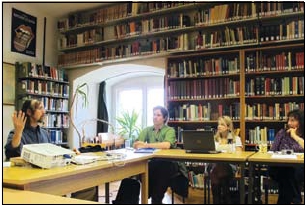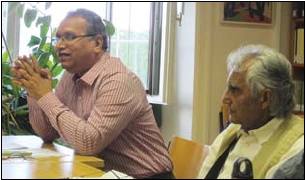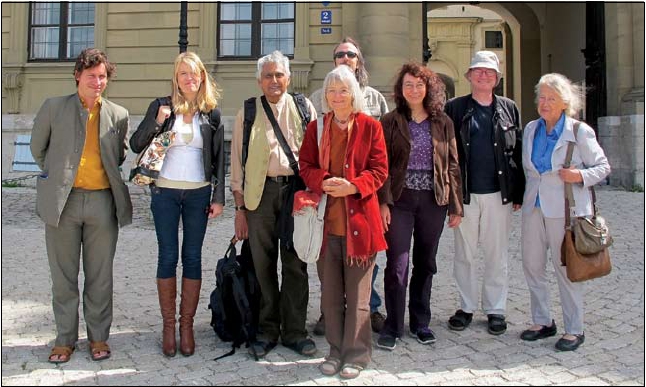
Centre of Jaina Studies Newsletter: SOAS - University of London
The Seventh International Würzburg Colloquium “Perspectives of Indian Studies”- Exploring Jain Narrative Literature, organized by Anna Aurelia Esposito and financed by the German Research Foundation (DFG), was held from 30 August to 1 September 2013 in Würzburg, Germany. Scholars from Austria, Belgium, Germany, Great Britain, India and Canada participated in the conference, which took place at the picturesque Würzburg Residence. The intention of the colloquium was to concentrate on the various dimensions- theological, philosophical, didactic, etc.- as well as on the communicative strategies characterizing Jaina narrative literature.
The conference was opened by Viveka Rai (Karnataka State Open University, Mysore / University of Würzburg), who focused on the concepts of ‘violence’ and ‘nonviolence’ in Yaśōdharacarite, a narrative poem written by the Kannaḍa poet Janna (*1163 AD). After comparing the Yaśōdharacarite with previous works on the same theme - Haribhadra’s Sanarāicchakahā, Har iṣeṇa’s Bṛhatkathākośa Somadeva’s Yaśastilakacampu, Puṣpadanta’s Jasaharacariu and Vadirāja’s Yaśodharacaritra - he elaborated on the different concepts and modes of violence in the Yaśōdharacarite: physical and barbaric brutality, mental torture, and the mere intention or thought of violence. The latter resulted in six rebirths and deaths of King Yaśōdhara and his mother Candramati as animals, before gaining again a human birth, embracing Jainism and becoming fnally ascetics.
Peter Flügel (SOAS) examined Jaina monastic biographies as sources for historical research. Starting with biographical texts from the late canonical period, he explained key changes in the paradigm of biographies. Furthermore, Flügel listed various sources for biographical information-besides literary works and personal narratives also songs, teacher- and succession lists, inscriptions or information beneath photos and paintings-and mentioned different strategies for manipulating genealogy. He convincingly showed that monastic biographies from the medieval period onward -even if mostly stereotyped- contain valuable historical and sociological information. With some difficulty, it is possible to reconstruct the social history of the Sthānakavāsī tradition on the basis of the biographical sources mentioned above.
 |
Jonathan Green, Tillo Detige, |
Jonathan Geen (King’s University College, London Ontario, Canada) investigated the development of the Pāṇḍava story in the various Śvetāmbara versions. While the earlier versions were mainly buried within accounts of the more detailed and significant exploits of the vāsudeva Kṛṣṇa, they became, beginning in the 13th century, more extensive. Geen explored some of the potential reasons for the rise in prominence of the Pāṇḍavas in Śvetāmbara tradition and pointed to two very different and distinct currents that ran through the medieval Śvetāmbara tradition of western India, beginning in the 13th century: The first of these currents was an increasing interest among Jaina poets in composing ornate courtly poems or dramas on subjects not at all, or only marginally, related to Jainism, that resulted in the liberation of the Pāṇḍavas’ biography from the suppressive constraint of the Universal History. The second current began in 1313 CE with the destruction of the temples on Mt. Śatruñjaya by the invading armies of Allauddin Khalji, the Tughlak Sultan of Delhi, and their restoration only a couple of years later. Here the very practical need for accessible, heroic stories related to Mt. Śatruñjaya as a place of pilgrimage and temple building favoured again the popularity of the Pāṇḍavas. Śubhaśīla’s Pāṇḍavacaritra, a part of his larger Śatruñjayakalpavṛtti (15th century CE), appears to reflect the intersection of both currents.
Eva De Clercq (Ghent University, Belgium) focused on a specific ‘difficult’ episode of the normative Rāma telling: the case of Śambūka, the śūdra who unlawfully practices asceticism, and is therefore executed by Rāma. As De Clercq explained, it would have been impossible for the Jaina authors to include this episode as it stands in the Vālmīki Rāmāyaṇa in their retelling. There would have been no severe objection against a Śūdra performing tapas, and it would have been very difficult to legitimate the hero Rāma killing a mendicant for no clear reason. But instead of simply omitting this incident some Jaina authors, starting with Vimalasūri, chose place it in the very centre of the story: By transforming the śūdraŚāmbūka into a young prince, the son of Rāvaṇa’s sister Śūrpanakhā, who performs heroic austerities before being killed accidentally by Lakṣmaṇa, these Jaina authors raised Śambūkas death to be the catalyst for later events: It is to avenge the death of his nephew Śambūka that Rāvaṇa goes to the Daṇḍaka forest in the first place. De Clercq concluded convincingly that this transformation of the character, and the advancement of his story, can be seen as deliberate attempts by the Jaina authors to criticize the orthodox versions of the Rāma story and the broader Brahminical restrictions in religious activities for certain groups of people.
 |
Willem and Annegret Bollée, Adelheid Mette |
Tillo Detige (Ghent University) criticised the Western approach to Jainism based on its exclusive location of ‘true’ religion in its sacred scriptures; its universally presupposed dichotomy of ‘pure’/early vs later/ degenerated tradition; and its notion of religion as belief in doctrines. These preconceptions were not beneficial for the study of Jaina narrative literature, which was mostly excluded as a source for understanding the nature of Jainism. Detige, on the contrary, showed the centrality of narratives in the Jaina religious tradition. Furthermore, he convincingly argued for the importance of integrating them in our model of Jainism, that is, for taking the stories seriously and situating them in their commensurate place at the heart of Jainism.
Luitgard Soni (Philipps-Universität Marburg) expanded on Hariṣeṇa’s Bṛhatkathākośa, an important collection of tales completed in 931 CE. The Bṛhatkathākośacontains 155 stories of different origin, including some quite well known tales such as the stories of the merchant Cārudatta or King Śreṇika. Works like the Bṛhatkathākośa are mostly thought of as collections of artha- and dharmakathās. While some stories cause saṃvega, others don’t ft into that theme. As Soni emphasized, these tales have are not only only didactic, there is an additional aspect: these stories are to be understood as ārādhanā-kathās-a fact that had been already stated by Hariṣeṇa in his praśasta. Whispered into the ear by the niryāpaka, they help the dying monk to endure the physical and mental pain and act as a kind of ‘drink’ for the dying person. In this way, Soni showed that we cannot really understand Hariṣeṇa’ṣ stories without taking into consideration the situation to which they are linked.
Starting from the frst occurrences in the Śvetāmbaracanon, Adelheid Mette (Ludwig-Maximilians-Universität München) compared various references to bāla-tapas/ bāla-tapasvin in Jaina canonical and philosophical literature. As Umāsvāti says in his TattvārthādhigamasūtraVI.20, bāla-tapas is one way to gain a rebirth as a god; this is, as Mette showed, actually the case in the Viyāhapannatti for Tāmali, Pūraṇa and Vesiyāyaṇa and in the Āvassaya-tradition for Indanāga. In the light of these stories, she challenged the common translations of the compound bāla-tapas.
 |
Viveka Rai and Jayandra Soni |
Jayandra Soni (Philipps-Universität Marburg) reported on Bhogilāla Jayacandbhāī Saṇḍesarā (1917-1995) and his contribution to Jaina studies. Interestingly enough, Saṇḍesarā did not come from a Jaina family. At the age of 14 he was introduced to Jaina literature by Muni Jinavijayajī and Muni Puṇyavijayajī and developed an extreme interest in the literature of Gujarat, be it in Sanskrit, Prakrit, Apabhraṃśa, in old and modern Gujarātī, or in Hindī. Soni gave an account of Saṇḍesarā’s immensely rich oeuvre, his academic activities, and the awards bestowed on him. Furthermore, Soni referred to his broad academic view, grounded in his expertise in a combination of history and literature, and his authoritative results, always based on reliable sources. A great desideratum is a complete annotated bibliography of Saṇḍesarā’s works; as many contributions are in Gujarātī, summaries and perhaps even translations of important parts would be indispensable-an immense task, which Soni is now working on.
The conference was concluded by Anna Aurelia Esposito (University of Würzburg), who concentrated on the transmission of religious as well as moral contents in Saṅghadāsa’s Vasudevahiṇḍī, the oldest extant work of Jaina narrative literature (based on a project fnanced by the German Research Foundation (DFG)). Esposito characterized some strategies intended to communicate religious teachings. These included the use of the dialogue as legitimation, as proof for the absolute truth of the Vasudevahiṇḍī; the accumulation of narrative layers and the narration of complex rebirth stories as an illustration of and recreation of the complex and incomprehensible nature of the world; and, finally, the negotiation of certain philosophical questions, such as the relationship between puruṣa and prakṛti or the existence of individual souls.
A generous time frame made it possible to discuss the participants’ presentations in depth in a serene atmosphere. A highlight was the presence of Professor Willem B. Bollée, who came with his wife Annegret from nearby Bamberg to attend part of the conference.

Anna Aurelia Esposito is assistant professor at the University of Würzburg, Germany. She is currently working on a project granted by the German Research Foundation about the transmission of religious and moral contents in Jain narrative literature.
 Dr. Anna Aurelia Esposito
Dr. Anna Aurelia Esposito